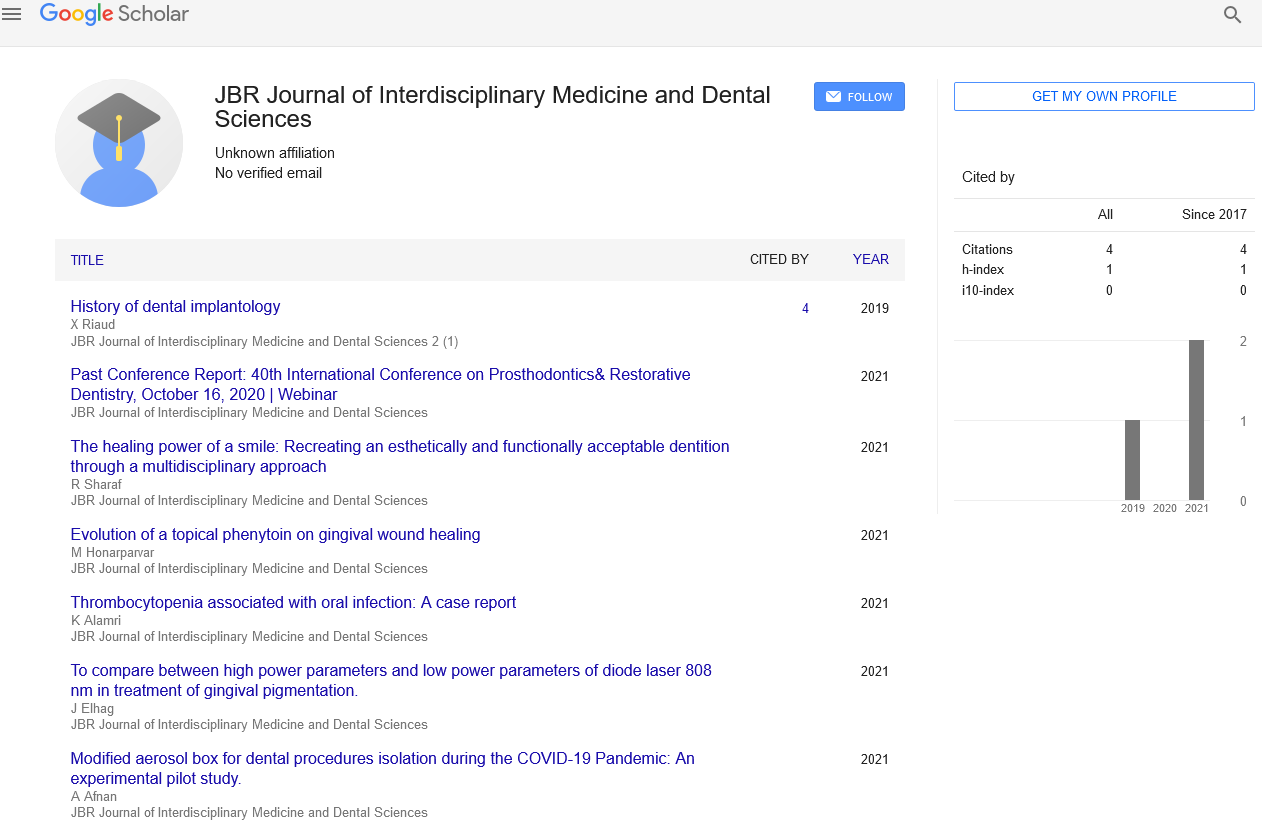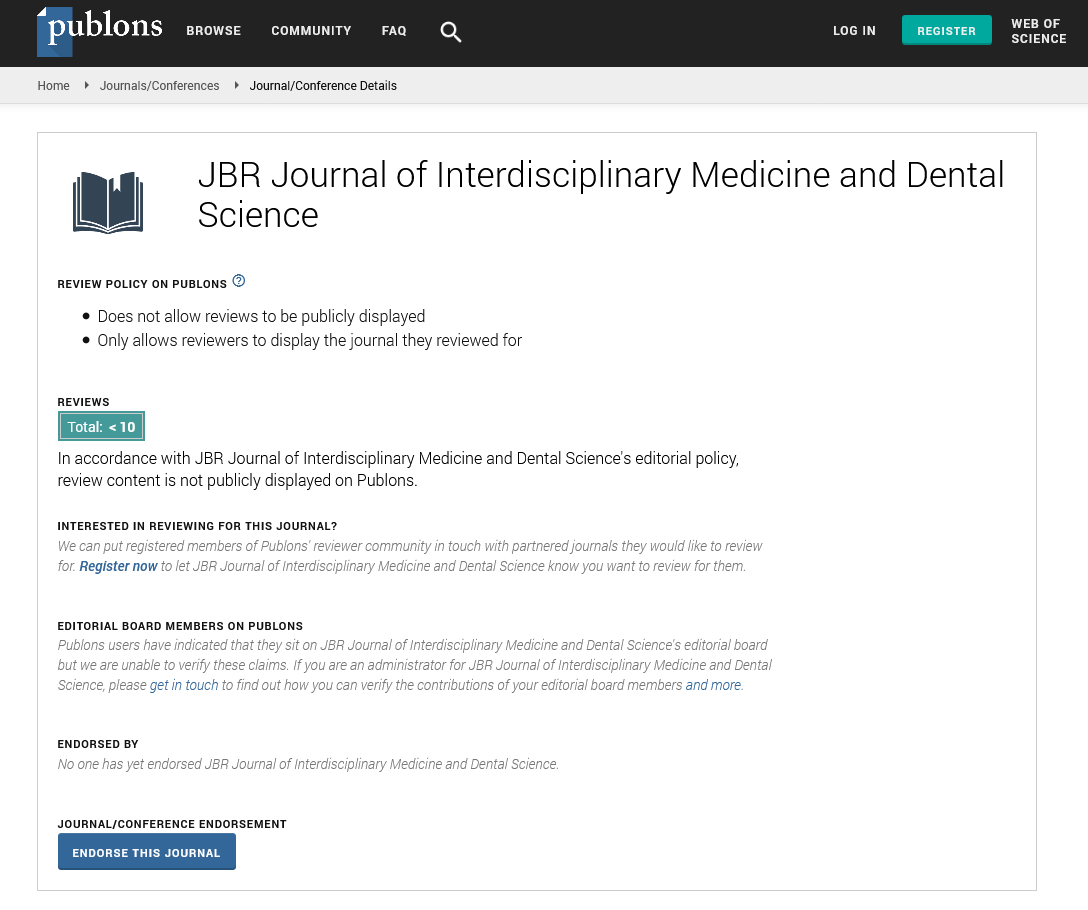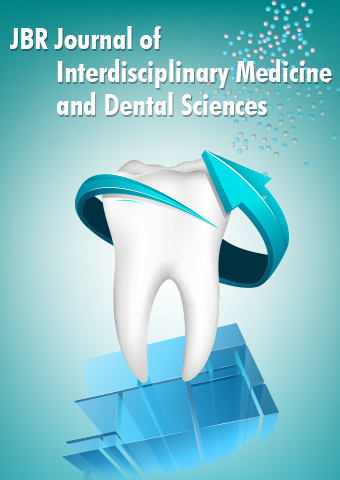Commentary - JBR Journal of Interdisciplinary Medicine and Dental Sciences (2022) Volume 5, Issue 3
A Note on Dental Implant Systems.
Yoshiki Oshida*
Department of Mechanical and Aerospace Engineering, Syracuse University, Syracuse NY 13244, USA
Department of Mechanical and Aerospace Engineering, Syracuse University, Syracuse NY 13244, USA
E-mail: yoshida@iupui.edu.
Received: 02-May-2022, Manuscript No. jimds-22-31002; Editor assigned: 03-May-2022, PreQC No. jimds-22-31002; Reviewed: 16- May-2022, QC No. jimds-22-31002; Revised: 23-May-2022, Manuscript No. jimds-22-31002(R); Published: 30-May-2022 , DOI: 10.37532/2376- 032X.2022.5(3).54-55
Abstract
There are various dental materials and their successful applications; a dental implant is a good example of the integrated system of science and technology involved in multiple disciplines including surface chemistry and physics, biomechanics, from macro-scale to Nano-scale manufacturing technologies and surface engineering. As many other dental materials and devices, there are crucial requirements taken upon on dental implants systems, since surface of dental implants is directly in contact with vital hard/ soft tissue and is subjected to chemical as well as mechanical bio-environments. Such requirements should, at least, include biological compatibility, mechanical compatibility, and morphological compatibility to surrounding vital tissues. In this review, based on carefully selected about 500 published articles, these requirements plus MRI compatibility are firstly reviewed, followed by surface texturing methods in details [1]. Normally dental implants are placed to lost tooth/teeth location(s) in adult patients whose skeleton and bony growth have already completed. However, there are some controversial issues for placing dental implants in growing patients.
Keywords
traumatization • cementation • anatomic consequences
Introduction
Responding to this ultimate goal, dental implants are an ideal option for people in good general oral health who have lost a tooth (or teeth) due to periodontal disease, an injury, or some other reasons [2]. Dental implants (considered as an artificial tooth root) are biocompatible metal anchors surgically positioned in the jaw bone (in other words, surgically traumatized bone) underneath the gums to support an artificial crown where natural teeth are missing. Using the root form implants (the closest in shape and size to the natural tooth root), the non-union (due to traumatization) bone healing period usually varies from as few as three months to six or more. During this period, Osseo integration occurs [3]. The bone grows in and around the implant creating a strong structural support, to which a superstructure will be attached later on by either cementation or screwtightening retaining technique
The number of dental implants used in the United States ever increased an estimated four-fold from 1983 to 1987, and it further increased 75% between 1986 and 1990 . At the beginning of this century, it was reported that there were 25 dental implants manufacturers with marketing about 100 different dental implant systems with variety of diameters, lengths, surfaces, platforms, interfaces, and body shape.
Description
Significant differentiation and distinctions are based on (i) the implant/abutment interface, (ii) the body shape, and (iii) the implant-to-bone surface. This remarkable increased need and use of implant-treatments may result from the combined effect of a number of factors; including (1) aging population, (2) tooth loss related to age, (3) anatomic consequences of edentulism, (4) poor performance of removable prostheses, (5) psychologic aspects of tooth loss, (6) predictable long-term results of implant-supported prostheses, and (7) advantages of implantsupported prostheses. Additionally, the host environment has been shown directly influence the biomaterial-to-tissue interface zone specific to the local biochemical and biomechanical circumstances of healing and longer term clinical aspects of load-bearing function [4]. The interaction at interface between recipient tissues and implanted material are limited to the surface layer of the implant and a few nanometers into the living tissues. The details of the interaction (hard or soft tissue) and force transfer that results in static (stability) or dynamic (instability or motion) conditions have also been shown to significantly alter the clinical longevities of intraoral device constructs.
This includes materials used professionally and the over-the-counter products sold directly to the public. The Dental Panel places an item one of three classes: Class I, materials posing minimum risk: these are subject only to good manufacturing and record keeping procedures. Class II, materials for which safety and efficacy needs to be demonstrated and for which performance standards are available: materials must be shown to meet the performance standard [5]. Class III, materials that pose significant risk and materials for which performance standards have not been formulated: this class is subject to premarket approval by the FDA for safety and efficacy, in much the same manner as a new drug.
Acknowledgement
None
Conflict of interest
No conflict of interest
References
- Brånemark PI, Zarb GA , Albrektsson et al. T Tissue-Integrated Prostheses; Osseointegration in Clinical Dentistry. Quintessence: Chicago, IL, USA, pp.175-186(1985).
- J Dent. National Institutes of Health consensus development conference statement on dental implants. Educ. 52, 686-691(1988).
- Stillman N, Douglass CW. Developing market for dental implants. J. Am. Dent. Assoc. 124, 51-56(1993).
- Binon PP. Implants and Components. Int. J. Oral Max. Implants 15, 76-94(2005).
- Misch CE. In Contemporary Implant Dentistry. Misch, C.E., Ed.; Mosby, Inc.: St. Louis, MO, USA, Chapter 1, p. 3(1993).


